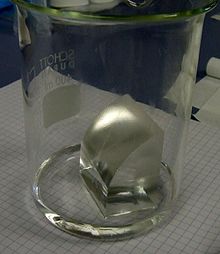Lithium fluoride

| |
 | |
 | |
| Names | |
|---|---|
| IUPAC name
Lithium fluoride
| |
| Identifiers | |
3D model (
JSmol ) |
|
| ChemSpider | |
ECHA InfoCard
|
100.029.229 |
| EC Number |
|
PubChem CID
|
|
RTECS number
|
|
| UNII | |
CompTox Dashboard (EPA)
|
|
| |
| |
| Properties | |
| LiF | |
| Molar mass | 25.939(2) g/mol |
| Appearance | White powder or colorless hygroscopic crystals
|
| Density | 2.635 g/cm3 |
| Melting point | 845 °C (1,553 °F; 1,118 K) |
| Boiling point | 1,676 °C (3,049 °F; 1,949 K) |
| 0.127 g/(100 mL) (18 °C) 0.134 g/(100 mL) (25 °C) | |
Solubility product (Ksp)
|
1.84×10−3[1] |
| Solubility | soluble in HF insoluble in alcohol |
| −10.1·10−6 cm3/mol | |
Refractive index (nD)
|
1.3915 |
| Structure | |
| Face-centered cubic | |
a = 403.51 pm
| |
| Linear | |
| Thermochemistry | |
Heat capacity (C)
|
1.507 J/(g·K) |
Std molar
entropy (S⦵298) |
35.73 J/(mol·K) |
Std enthalpy of (ΔfH⦵298)formation |
-616 kJ/mol |
| Hazards | |
| GHS labelling: | |

| |
| Danger | |
| H301, H315, H319, H335[2] | |
| NFPA 704 (fire diamond) | |
| Lethal dose or concentration (LD, LC): | |
LD50 (median dose)
|
143 mg/kg (oral, rat)[3] |
| Related compounds | |
Other anions
|
Lithium chloride Lithium bromide Lithium iodide Lithium astatide |
Other cations
|
Sodium fluoride Potassium fluoride Rubidium fluoride Caesium fluoride Francium fluoride |
Except where otherwise noted, data are given for materials in their standard state (at 25 °C [77 °F], 100 kPa).
| |
Lithium fluoride is an inorganic compound with the chemical formula LiF. It is a colorless solid that transitions to white with decreasing crystal size. Its structure is analogous to that of
Manufacturing
LiF is prepared from lithium hydroxide or lithium carbonate with hydrogen fluoride.[5]
Applications
Precursor to lithium hexafluorophosphate for batteries
Lithium fluoride is reacted with
The lithium fluoride alone does not absorb hydrogen fluoride to form a bifluoride salt.[6]
In molten salts
Fluorine is produced by the electrolysis of molten potassium bifluoride. This electrolysis proceeds more efficiently when the electrolyte contains a few percent of LiF, possibly because it facilitates formation of an Li-C-F interface on the carbon electrodes.[4] A useful molten salt, FLiNaK, consists of a mixture of LiF, together with sodium fluoride and potassium fluoride. The primary coolant for the Molten-Salt Reactor Experiment was FLiBe; 2LiF·BeF2 (66 mol% of LiF, 33 mol% of BeF2).
Optics
Because of the large
Radiation detectors
It is also used as a means to record
3Li
(n,alpha) nuclear reaction) in thermoluminescent dosimeters. 6LiF nanopowder enriched to 96% has been used as the neutron reactive backfill material for microstructured semiconductor neutron detectors (MSND).[8]
Nuclear reactors
Lithium fluoride (highly enriched in the common isotope lithium-7) forms the basic constituent of the preferred fluoride salt mixture used in
Cathode for PLED and OLEDs
Lithium fluoride is widely used in
Natural occurrence
Naturally occurring lithium fluoride is known as the extremely rare mineral griceite.[10]
References
- ISBN 978-1138561632.
- ^ "Lithium fluoride - Product Specification Sheet". Sigma-Aldrich. Merck KGaA. Retrieved 1 Sep 2019.
- NLM. Archivedfrom the original on 12 August 2014. Retrieved 10 Aug 2014.
- ^ ISBN 9783527303854.
- S2CID 19657691.
- ISBN 978-3527306732.
- ^ "Lithium Fluoride (LiF) Optical Material". Crystran 19. 2012.
- hdl:2097/16983.
- .
- ^ "Griceite mineral information and data". Mindat.org. Archived from the original on 7 March 2014. Retrieved 22 Jan 2014.

